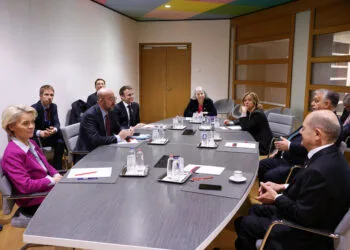Brussels – A flash deal to make funds available as soon as possible for Ukraine’s recovery, reconstruction, and modernization to 2027. Five days after the European Council approved the crucial understanding on the interim review of the EU 2021-2027 Multi-annual Financial Framework, negotiators from the EU Parliament and Council found overnight yesterday and today (Feb. 5-6) the provisional agreement on the establishment of the Facility on Ukraine with a total of 50 billion euros and based on three pillars to provide Kyiv with “coherent, predictable, and flexible” support for the next four years.

“This Parliament has supported our proposal from the very beginning. I want to thank you for your unwavering support,” stressed EU Commission President Ursula von der Leyen this morning as she opened her speech in the Plenary session of the European Parliament in Strasbourg. “With your approval, we will be able to make important payments to Ukraine as early as March.” European Council President Charles Michel added: “This is the unity and determination of the Union in firmly supporting Ukraine.” According to the agreement between the co-legislators – which will now have to be approved by the individual EU institutions along with the still-pending budget review before entering into force the day after its publication in the EU Official Journal – the total budget to be allocated until 2027 will be 50 billion euros, divided into 33 billion in loans and 17 billion in grants, with no tweaks from what was put on the table by the von der Leyen cabinet.
The new financial instrument is based on three pillars. The first is the Plan for Ukraine, to be prepared by the government in Kyiv to “set out its intentions” for the recovery and reconstruction of the country, but also for the reforms within the EU accession process. Financial support will be provided according to the implementation of this plan, with “a set of conditions and a timetable for disbursements.” The second pillar is the Investment Framework for Ukraine, within which the Union will provide support in the form of budget guarantees and a combination of grants and loans from public and private institutions. Finally, the third is specific assistance to EU accession “and other support measures” for alignment with EU legislation and set structural reforms towards future EU membership.
How funds will reach Ukraine
.

EU Commission President Ursula von der Leyen, a Kiev (November 4, 2023)
As for allocations, the €17 billion in grants will be mobilized through the Ukraine instrument agreed by 27 EU leaders in the context of the revised QFP, while the €33 billion in loans will be secured from the own resources reserve, just as in the Macro-Financial Assistance Plus (MFA+) funding that mobilized 18 billion throughout 2023. Under the Plan for Ukraine, Kyiv can request up to 7 percent in pre-financing, with “a significant share” of the first two pillars earmarked for green investments and another part of the Investment Framework reserved for small and medium-sized enterprises.
Since the country is still at war (in 18 days, it will be two years since the Russian invasion began), there will be “some flexibility in budget management,” However, the respect of democratic mechanisms — “including a multi-party parliamentary system” – the rule of law, human, and minority rights is still a prerequisite for support through the new financial Instrument. The Regulation establishing the Ukraine Instrument ensures that the Verkhovna Rada (the Ukrainian Parliament) and civil society organizations are “duly informed and consulted” on the design and implementation of the first pillar on recovery and reform intentions for EU accession. An annual debate is planned in the Council from the Commission’s special reports on the implementation of the Instrument, while the European Parliament will be able to invite the EU executive to discuss it “at least every four months.” The Regulation will include a scoreboard to make it easier to monitor the “progress of the various qualitative and quantitative steps, including an overview of the social, economic, and environmental elements” of the Ukraine Plan.







